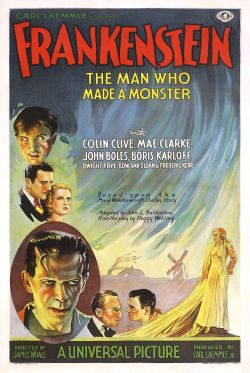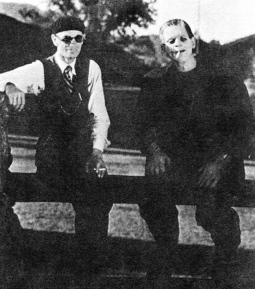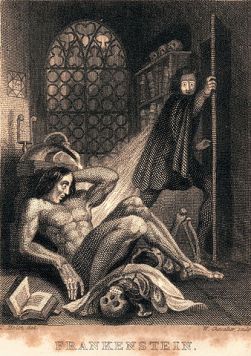Listen via website or copy this link into your podcast app.
Listen via YouTube Maybe… If I can work out the bugs.
This is our pilot episode in which Brent and I stumble through the disparate plot points of the 1818 gothic novel Frankenstein or the Modern day Prometheus by Mary Shelley and the 1931 movie Frankenstein directed by James Whale and adapted by James L. Balderston.
The differences between the novel and the movie are so numerous that listing them in detail would take forever.
But here are the 10 most notable differences we touched on in our podcast.
10 Differences Between the Book and the Movie of Frankenstein
 1. Victor vs. Henry
1. Victor vs. Henry
The 1931 movie changes the name of Doctor Frankenstein from Victor to Henry. Maybe in an effort to make him more appealing? They take other steps to redeem the mad scientist, Fritz, for example, is the manifestation of some of the traits that don’t make the transition from the Victor of the book to Henry of the film. Because he is animating his creature somewhat in the open in the film he doesn’t need to be as duplicitous as he is in the novel. He also doesn’t sully his hands with a lot of the more gruesome aspects of the creation of his creature and is thus, more acceptable, maybe?
He is, of course, still an awful human being.
2. The Creature vs. The Monster
The movie denies the Creature a voice and denies his the ability to be perceived as an innocent. Whilst the Creature of the novel is depicted sympathetically, with the capacity to learn and love, the Monster of the film still shows some of that potential but as he has no voice and basically no time to develop in any way. The space and time afforded to the creature through his solitude is key to the relatability of Frankenstein’s creation in Shelley’s novel. But James Whale didn’t have the luxury of a whole novel to develop his Monster’s character, but you can see the humanity of Boris Karloff’s bumbling creature in his confusion, fear and desire to understand and explore the world around him.
3. The Fritz Situation
Fritz is the vehicle for all that is distasteful in the creation process. His absence in the novel means that Victor is reliant on his own resources. He also has a bitter and morose internal monologue that would have not translated to screen. An assistant allows him to neatly offload scientific exposition, with the added feature that Fritz is a dislikeable low stakes person for the monster’s first kill.
4. Bad Brains
The movie gives us the brain mix up as an easy out to the dilemma that Shelley sets up… to what extent does Frankenstein harbour responsibility for his creatures actions, and to what extent are the frightened humans of the story culpable for what the creature becomes? If we are to believe that a criminal brain is only capable of criminality as posited by Doctor Waldman then surely the monster was only capable of dangerous or criminal behaviour. In one neat action, Fritz dropping the brain gives us a scapegoat and an excuse for dispatching a creature that is problematic.
5. Elizabeth
Elizabeth still has a limited presence in the film, in the novel she is both an object to be desired and a person Victor can project his mother issues onto. In the movie, however, she is denied even that level of depth. Although Frankenstein does seem to value her more highly than his friend (Victor in the film, Henry in the novel) which is more than I can say for Victor’s respect for her in the novel. Mary Shelley is not unsympathetic to Elizabeth, she advocates for the innocent Justine, despite how deeply affected she is by William’s death. She is loyal, compassionate, intelligent and courageous, all of which seems to be lost on Victor.

6. The Crimes of the Creature
It takes the creature months to kill someone and a lot of awful things have happened to him, pushing him to the edge. The movie has the Creature killing Fritz within the first day of his existence, then Dr Waldman and then little Maria (the girl whose dad left her by the lake with a cat that is very clearly dead as her companion. There is also a slew of violent attacks including his weird predatory attack on Elizabeth and culminating in his attempt destroy his creator. He is painted as violent, but that violence springs from fear rather than hatred. The novel has the space to complicate and problematize the Creature’s crimes further. His first crime is arson as he attempts to gain some impotent vengeance on the DeLacy family who rejected him, this is the point at which the Creature snaps. From here on he carries out the brutal murder of little William Frankenstein, frames the unfortunate and noble Justine and fixates on bringing about a kind of exquisite suffering on Victor. There is a moment of hope, in which the Creature reaches out to Victor to end his isolation and lessen his suffering. He asks for a companion, why he thinks that introducing another creature to the level of suffering he experiences seems like a reasonable thing to him is one of the most unreasonable and illogical expectations the Creature has. But the destruction of his bride breaks this fraught truce and the Creature then kills those closest to Victor, his best friend Henry and his wife Elizabeth. This is his final crime, although Victor will attempt to blame the death of his father and his own suffering through the subsequent chase on the Creature.
7. The Missing Letters
The very effective framing narrative of Walton’s expedition, which sets the tone for the entire novel, is entirely missing from the movie. We come to the movie with only a few minutes of introduction from an announcer giving a monologue or prologue warning of the horror that is about to ensue. This change in framing redirects our attention somewhat away from the ethical dilemma of creation at play and onto the monstrosity of the creature itself. Walton’s doomed expedition primes us for Victor’s obsession, without this framing narrative the focus can be shifted slightly away from the dangerous ambition and self-centred hubris. That is to say that without Walton spend more time beholding the monstrous spectacle of the creature, than the monstrous spectacle of his creator.
8. The Outcome
In the movie, the audience can rest safely knowing that the town and the doctor are safe and that he might have learnt his lesson. The creature appears to be dead and everything seems to be tied up in a neat little bow. Shelley, on the other hand, leaves us with a tragic end. Everyone is dead, doomed or miserable. Walton’s men may get out of the icy wastelands alive but that is as close to a happy ending as we get. The creature remains alive but has no desire to stay that way.
9. The Swiss Landscape
The Switzerland of the film is villages, lakes and windmills. But the novel is able to give us a more complex look at the Swiss landscapes and their surrounds with the Creature and Victor undertaking vast treks, depicted through sweeping descriptive romantic prose. The Swiss are depicted as a noble society in the novel, but unfortunately, the movie only deals in villager stereotypes and class-based stereotypes.

10. The Moral of the Story
If I was to grossly simplify the message of each text into an easy to digest statement it would probably go thus:
The movie: Creation is dangerous, entities can be born evil and it takes a village and a hero to bring down a monster.
The novel: The cruelty and ambition of man are inherently dangerous and should not be left unchecked.
References
Shelley Wollstonecraft, Mary. “Frankenstein or The Modern Prometheus.”
Different editions used listed below
- Project Gutenberg: http://www. gutenberg. org/files/84/84-h/84-h. htm (2008).
- Norton Critical Edition
- Audible Audio book narrated by Dan Stevens
- Gothic Treasury of the Supernatural
Frankenstein (1931), Universal Pictures. http://www.imdb.com/title/tt0021884/
Hitchcock, Susan Tyler. Frankenstein: A cultural history. WW Norton & Company, 2007.
And a whole bunch of articles I didn’t write down. I promise I’ll do better
18 Comments Add yours